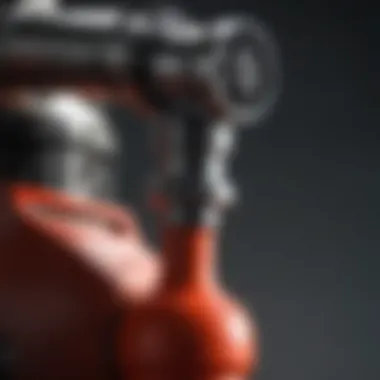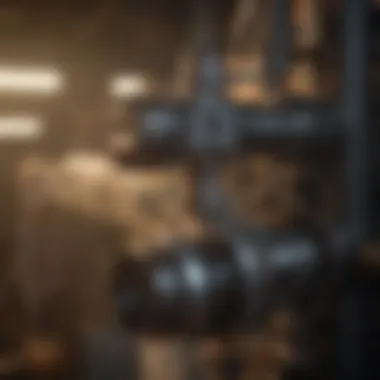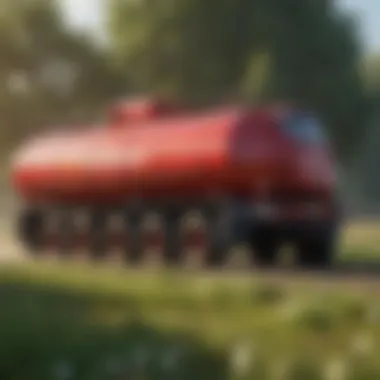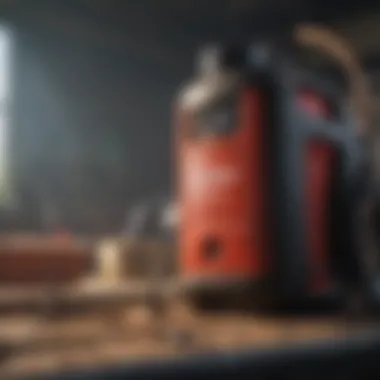In-Depth Guide to Northern Star Sprayer Parts


Overview of the Topic
Definition and Importance
The Northern Star sprayer parts play a crucial role in modern agriculture. These components are essential for effective pesticide, herbicide, and fertilizer application. Properly functioning sprayer parts ensure that the application is uniform and accurate. This is vital for crop health and maintaining yields. Poor maintenance or incompatible parts can lead to inefficient spraying, which can damage crops or harm the environment.
Current Trends
Innovation in agricultural spraying technology is on the rise. Farmers are increasingly focusing on sustainability and efficiency. Many are adopting precision agriculture techniques, allowing them to apply sprays in a targeted manner. This reduces waste and environmental impact. Additionally, there is a trend towards using flexible and adaptable sprayer components, compatible with various machines, enhancing versatility and ease of maintenance.
Key Techniques and Practices
Step-by-Step Guide
- Assessment of Needs: Begin by identifying the specific spraying requirements for your crops. Consider factors like crop type and growth stage.
- Choosing Parts: Select appropriate Northern Star sprayer parts that fit your sprayer model. Ensure compatibility to avoid operational issues.
- Installation: Follow the manufacturer's instructions for proper installation of the sprayer parts. This step is crucial for ensuring efficient operation.
- Regular Maintenance: Schedule regular check-ups of each component. Look for wear and tear, and replace any damaged parts promptly to ensure optimal performance.
- Calibration: Adjust the sprayer settings to ensure accurate and even distribution of the spray. Proper calibration maximizes effectiveness and minimizes waste.
Tools and Equipment Needed
For effective operation, certain tools and equipment are necessary, including:
- Wrenches and screwdrivers for assembly and maintenance.
- Calibration tools to ensure the correct application rate.
- Protective gear, like gloves and goggles, to ensure safety during operation.
Challenges and Solutions
Common Obstacles
Farmers often face various challenges related to sprayer parts. These can include:
- Compatibility Issues: Not all sprayer parts work well with every other brand. This can lead to poor performance.
- Wear and Tear: Frequent use can cause parts to degrade over time, affecting efficiency.
- Sourcing Parts: Finding the right parts can sometimes be difficult, especially for older models.
Innovative Solutions
Addressing these challenges involves a few strategies:
- Research: Stay informed about innovative products and solutions in the market.
- Networking: Join forums such as reddit.com, where farmers share insights and experiences.
- Maintenance Practices: Adopt proactive maintenance to prolong the life of equipment. This can reduce overall costs and improve efficiency.
"Regular maintenance and proper parts selection can drastically improve operational efficiency, ultimately benefiting both crop yield and sustainability."
For additional information and best practices, you might want to explore resources on Wikipedia, and Britannica. Those platforms offer a wealth of insights into agricultural techniques and technologies.
Prelude to Northern Star Sprayers
Understanding Northern Star sprayers is vital for professionals in agriculture. These sprayers serve as essential tools for applying fertilizers, pesticides, and other agricultural chemicals efficiently. A comprehensive overview of their components, maintenance, and compatibility ensures effective use in diverse field situations.
Overview of Sprayer Technology
Sprayer technology has evolved significantly over recent years. Modern sprayers are designed with advanced mechanisms that improve efficiency and reduce environmental impact. Northern Star sprayers incorporate cutting-edge technology to meet the demands of contemporary farming. This includes electric pumps that regulate flow more precisely and nozzles designed for optimal coverage. The integration of GPS and automated systems in sprayers enables farmers to monitor and adjust application rates in real time, leading to increased productivity.
Farmers benefit from understanding these technologies. It helps them select the right sprayer based on their specific needs and conditions, increasing overall efficacy in the field. Additionally, being familiar with the technology used in Northern Star sprayers facilitates better troubleshooting and repairs when issues arise.
Importance of Quality Components
Quality components are the backbone of effective sprayer performance. In agricultural spraying, durability and reliability are critical. Components such as pumps, nozzles, and tanks must withstand harsh conditions and deliver consistent results. Poor-quality parts can lead to inadequate spray patterns and increased downtime due to failures.
When dealing with Northern Star sprayers, farmers must prioritize the quality of the parts they choose for maintenance or replacement. The costs associated with low-quality components can outweigh initial savings, resulting in more frequent repairs and reduced productivity.
"Investing in quality parts is an investment in the future of farming. It ensures efficiency and sustainability in agricultural practices."


Components specifically designed for Northern Star sprayers tend to have better compatibility and performance. Hence, understanding this aspect can significantly improve operational efficiency, ultimately benefiting yields and profitability.
Understanding Sprayer Components
Understanding sprayer components is essential for anyone engaged in agricultural practices. Each part plays a critical role in ensuring the sprayer operates efficiently, effectively applying chemicals, fertilizers, and other substances. A well-designed sprayer not only enhances the quality of application but also optimizes resource use, which is vital for sustainable farming. By gaining an in-depth understanding of these components, farmers and enthusiasts can make informed decisions regarding maintenance, upgrades, and replacements.
Pump Mechanisms
The pump is one of the most vital parts of any sprayer. It creates the pressure required to propel the fluid through the system, ensuring an even distribution over the target area. There are several types of pumps, including diaphragm and centrifugal models, each with unique advantages.
- Diaphragm Pumps are commonly used for spraying viscous liquids and can handle a variety of chemicals. Their ability to self-prime is advantageous in many scenarios.
- Centrifugal Pumps, on the other hand, are preferred for their efficiency on larger units and can maintain a consistent pressure.
Understanding the characteristics of the pump mechanism can significantly impact the performance of the sprayer. Choosing the right pump based on the specific agricultural needs is crucial.
Nozzle Types and Functions
Nozzles play a critical role in the performance of a sprayer by regulating the flow of liquid. There are various nozzle types such as flat fan, hollow cone, and full cone, each designed for specific applications.
- Flat Fan Nozzles are suitable for broad coverage and are commonly used for even distribution on flat surfaces.
- Hollow Cone Nozzles help create smaller droplets, perfect for targeted spray areas like trees or shrubs.
- Full Cone Nozzles provide a wide spray pattern, ideal for applications needing a solid coverage, like preventing soil erosion.
Choosing the right nozzle type directly affects the efficiency and effectiveness of the spraying process.
Tank Construction and Capacity
The tank stores the liquid mixture before application. Its construction should be durable, often made from high-density polyethylene or stainless steel, depending on the type of chemicals used. The tank’s capacity is equally important; it needs to be adequate to allow efficient coverage for the intended application area, minimizing the need for frequent refills.
- Small Tanks can be more maneuverable in tight spaces but may require frequent refills for larger jobs.
- Larger Tanks allow for extended operation but may reduce mobility and increase the vehicle's overall weight.
Understanding the tank's features gives farmers better control over their spraying operations.
Hoses and Fittings
Hoses and fittings are the conduits through which the liquid travels from the pump to the nozzle. The material and diameter of hoses can influence flow rates and pressure. Common materials include rubber and PVC, each providing unique durability and flexibility.
- Using the correct fittings is essential to prevent leaks and maintain system pressure.
- Compatibility between hoses and fittings is crucial, as mismatched parts can lead to operational inefficiencies.
Regular inspection of hoses for wear and tear is important to ensure effective operation.
Control Systems and Electronics
Modern sprayers often come equipped with advanced control systems that enhance usability and precision.
- Electronic Controllers allow for automated adjustments based on application rates, ensuring uniformity and efficiency.
- GPS Technology is gaining popularity, enabling precision agriculture practices by optimizing spray patterns and reducing chemical waste.
Farmers should consider these systems when investing in sprayer technology, as the right setup can lead to significant savings and better crop yields.
Understanding the composition and functionality of each sprayer part can greatly enhance operational efficiency and sustainability practices.
By grasping the intricacies of sprayer components, agricultural professionals can improve application precision and reduce waste of resources, ultimately fostering a more productive farming environment.
Maintenance of Northern Star Sprayer Parts
Maintaining Northern Star sprayer parts is crucial for ensuring optimal performance and longevity of the equipment. This practice not only enhances the efficiency of agricultural operations but also prevents costly downtimes and repairs. By following a systematic maintenance routine, users can extend the life of their sprayers, ensuring that they operate at peak capacity during critical planting and spraying seasons.
Routine Cleaning Practices
Routine cleaning is an essential part of sprayer maintenance. After each use, it is important to clean the tank, hoses, and nozzles thoroughly. This helps remove any residue from chemicals or fertilizers that may cause clogs or damage if left inside the sprayer.
- Flush the System: Always flush the sprayer with clean water. This removes any leftover chemicals, preventing corrosion and buildup within the system.
- Use Appropriate Cleaning Solutions: Depending on the substances used, specific cleaning agents may be required. For example, using a detergent suitable for agricultural equipment can help in breaking down stubborn residues.
- Pay Attention to Nozzles: Check and clean nozzle tips regularly. Clogged nozzles can lead to uneven spraying, which affects application effectiveness.


These practices, though simple, are critical for maintaining the integrity of Northern Star sprayer parts.
Scheduling Regular Inspections
Regular inspections of sprayer components can seem tedious, but it is a proactive approach to maintenance. Scheduling inspections can lead to identifying potential issues before they develop into significant problems. Farmers should consider the following:
- Seasonal Checks: Inspect the sprayer at the beginning and end of each season. This ensures that all parts are operational when needed most.
- Daily Visual Inspections: Before and after use, doing a quick visual check at the equipment can help catch wear and tear early.
- Professional Servicing: Engage professionals for more thorough inspections. They can identify intricate issues that may not be visible to the untrained eye.
By adhering to a regular inspection schedule, users are more likely to catch issues early, reducing unexpected repair costs.
Identifying and Addressing Wear and Tear
Recognizing wear and tear on sprayer parts is pivotal for effective maintenance. Components such as hoses, seals, and nozzles are particularly prone to degradation over time.
- Visual Indicators: Look for cracks or fraying on hoses. These can weaken the system, leading to leaks and decreased pressure.
- Listening for Unusual Sounds: Pay attention to unusual noises during operation. This can be a sign that something is amiss within the pump or motor.
- Performance Monitoring: Track the performance of the sprayer. A decline in flow rate or inconsistency in spray pattern can indicate wear in critical parts.
Promptly addressing these signs of wear can prevent further damage and ensure that the sprayer works efficiently.
"A consistent maintenance plan not only enhances the efficiency of sprayers but also allows for sustainable agricultural practices."
By committing to these maintenance protocols, Northern Star sprayer owners can significantly enhance both the performance and lifespan of their equipment.
Compatibility Issues with Parts
Compatibility issues with sprayer parts are a critical focus in agricultural practice. Understanding these issues can significantly impact operational efficiency and reduce unexpected downtime. When components are not compatible, it can lead to suboptimal performance, potentially damaging the equipment or even posing safety risks. Farmers and agricultural professionals need a firm grasp on compatibility to make informed decisions about their sprayer systems.
Evaluating Part Specifications
When evaluating part specifications, it is essential to consider the exact requirements needed for each component. This assessment involves examining the dimensions, materials, and performance characteristics of the sprayer parts. Components such as pumps, nozzles, and hoses must align with the manufacturer's specifications to ensure seamless integration and operation. Always verify that the parts match the original equipment's specifications for optimal results.
- Dimensions: Check the size and fitting compatibility.
- Material: Consider the durability and resistance to chemicals.
- Performance: Ensure flow rates, pressure ratings, and other performance metrics align.
Taking these aspects into consideration not only minimizes the risk of compatibility issues but also prolongs the life of the sprayer equipment.
Cross-Compatibility with Other Brands
Considering cross-compatibility with other brands may also be beneficial. This aspect can offer more flexibility in sourcing parts and reduce costs. However, cross-compatibility comes with its own set of challenges. While some elements from different brands can fit, others may not work as effectively or safely. Thus, it is crucial to perform due diligence.
"Using parts from different brands can sometimes void warranties or lead to performance issues. Always check compatibility thoroughly before making a purchase."
Before selecting a part from another manufacturer, evaluate:
- Technical Specifications: Ensure they meet the same standards as the original parts.
- User Reviews and Feedback: Seek experiences from others who have used mixed-brand parts.
- Warranty and Support: Understand how using alternative brands may impact support from the original manufacturer.
Sourcing Northern Star Sprayer Parts
Sourcing parts for Northern Star sprayers is a critical consideration for agriculture professionals who depend on these machines for efficient operation. Identifying the right components enhances performance and prolongs the lifespan of the sprayer. Quality parts contribute to the overall effectiveness of the spraying process, reducing downtime and boosting productivity.
When looking for parts, one must pay attention to several elements. Authorized dealers and manufacturers often provide assurance of compatibility and quality. Evaluating online options can lead to cost savings and convenience, but one must also be cautious about the credibility of the sources. Additionally, second-hand parts might offer an economical alternative, though they present their own set of risks and rewards.
In the following sections, we will delve into these aspects, providing clarity on just how to navigate the marketplace for Northern Star sprayer parts.
Authorized Dealers and Distributors
Authorized dealers and distributors play a vital role in sourcing Northern Star sprayer parts. They are recognized by the manufacturer, ensuring that the parts sold are original and meet the required specifications.
Benefits of using authorized sources include:


- Quality Assurance: Original parts typically come with guarantees on performance and compatibility.
- Expert Advice: Dealers often have knowledgeable staff who can provide insights into the best parts for specific models.
- Warranty Coverage: Purchasing from authorized dealers can ensure that warranties remain valid, protecting the investment made.
Finding these dealers can often be done through the Northern Star website or contacting their customer service for recommendations. It is always advisable to choose the official channel for peace of mind.
Evaluating Online Purchase Options
In today's digital age, the online market presents many avenues for sourcing Northern Star sprayer parts. However, the vast array of options can be overwhelming. To navigate effectively, keep the following considerations in mind:
- Reputation of the Seller: Always check reviews or ratings of the online store to assess reliability.
- Return Policy: A clear return policy will provide a safety net in case the part does not meet expectations or specifications.
- Shipping Costs and Times: Understand the total cost including delivery, as this can affect the overall value of the purchase.
- Customer Support: Verify that the seller offers customer support for queries regarding the products.
Being thorough in evaluation can lead to positive purchasing experiences.
Second-hand Parts: Pros and Cons
Purchasing second-hand parts for Northern Star sprayers can be a double-edged sword. On one hand, the cost-effectiveness is appealing, but on the other, there are potential risks involved.
Pros:
- Cost Savings: Second-hand parts are usually sold at a significantly lower price than new parts.
- Availability: Hard-to-find components may be available in the second-hand market.
Cons:
- Uncertain Quality: Condition of used parts can range from excellent to poor, making quality assessment critical before purchase.
- No Warranty: Most second-hand parts do not come with a warranty, leaving buyers at risk if the part fails.
- Compatibility Issues: Ensuring that a second-hand part is compatible with your sprayer can be challenging without proper documentation.
"When sourcing any part, understanding the options and potential pitfalls is paramount to sustaining the performance of your machinery."
Navigating the sourcing of Northern Star sprayer parts is a detailed process that impacts overall operational efficiency. Being informed and resourceful leads to better decision-making and develops confidence for agricultural stakeholders.
Innovations in Sprayer Technology
Innovations in sprayer technology play a crucial role in enhancing the efficiency of agricultural practices. As the demand for higher crop yields and more effective pest control rises, sprayers must evolve. This evolution involves the integration of advanced designs, materials, and technologies that improve functionality and usability. Innovations directly impact the operational efficiency of farming equipment, which can result in cost savings and increased productivity for agricultural professionals.
Emerging Trends in Sprayer Design
The design of sprayers has seen notable advancements in recent years. Today's sprayers do not just focus on performance but also consider user experience and environmental safety. Automated sprayers with precision application technology minimize chemical usage and reduce environmental impact. Features like GPS guidance and data analytics are increasingly common. These features help farmers target specific areas that need treatment, improving efficiency.
Ergonomics is another important trend. Many manufacturers are rethinking the design of the sprayer components to create user-friendly equipment. This includes optimizing controls for better accessibility and comfort during operation. As a result, fatigue is reduced, and operators can work longer without discomfort.
Other notable trends include the development of modular sprayers that allow for easy upgrades and customization. These sprayers can be adapted based on operational needs or changes in agricultural practices, minimizing the need for significant investments in new equipment. Together, these trends indicate a shift towards smarter, more efficient spraying solutions.
Sustainability Practices in Sprayer Manufacturing
Environmental sustainability in sprayer manufacturing has gained attention. Many manufacturers are adopting methods to reduce their ecological footprint. This includes using recyclable materials in sprayer construction and implementing energy-efficient manufacturing processes. Such practices not only benefit the environment but also enhance the reputation of brands among environmentally conscious consumers.
Additionally, some manufacturers are focusing on reducing chemical runoff through better designed sprayer technologies. This can involve innovations such as drift reduction nozzles that minimize overspray and prevent chemicals from reaching unintended areas.
"Today’s sprayer technologies not only improve efficiency but also contribute to sustainable agricultural practices."
Incorporating feedback from users is essential in developing sustainable sprayer designs. By understanding the operational needs and challenges faced by farmers, manufacturers can create solutions that are both effective and environmentally friendly.
Finale and Future Considerations
The final segments of this article are crucial for understanding the broader implications of Northern Star sprayer parts in agricultural practices. These considerations not only tie together the specifics discussed but also reflect on the future landscape of spraying technology. Agricultural professionals must remain aware of evolving trends and adapt their operations accordingly.
As the industry evolves, it is important to highlight efficiency in the use of sprayers. This efficiency affects not only productivity but also environmental impacts. Farmers and agricultural enthusiasts need to make informed decisions based on both current practices and future innovations. This involves acknowledging the significance of high-quality components and maintaining them to ensure optimal performance.
Key considerations include:
- The relationship between sprayer efficiency and yield.
- The role of innovative technology in reducing waste and enhancing precision.
- Sustainable practices that not only improve operations but also protect the environment.
The efficient operation of Northern Star sprayers contributes significantly to modern agriculture, thereby necessitating a proactive approach to the maintenance and availability of parts.
Future considerations involve staying updated on advancements in sprayer technology. The agricultural industry is increasingly leaning toward smart technology. This includes integrated control systems that optimize performance and reduce resource consumption. Farmers must weigh the benefits of adopting new technologies against the costs involved. They should also consider their specific agricultural contexts and operational needs when making decisions about upgrading their sprayer equipment.
Effective communication and collaboration among industry stakeholders can lead to shared knowledge and innovations. This, in turn, can facilitate broader adoption of best practices and cutting-edge technology. Thus, the future of spraying equipment relies on both individual actions and collective efforts within the agricultural community.



